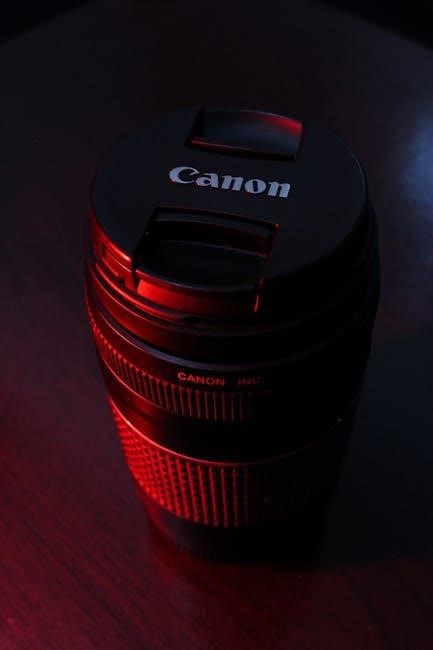Canon 60D Instruction Manual: A Comprehensive Guide
Embark on a photographic journey with the Canon EOS 60D! This comprehensive guide serves as your personal tutor, mastering every feature. From basic settings to advanced techniques, unlock the full potential and explore creative capabilities of your EOS 60D camera.
Welcome to the world of the Canon EOS 60D, a digital single-lens reflex camera designed for both aspiring and experienced photographers. This camera combines high-performance capabilities with user-friendly features, making it an excellent tool for capturing stunning images and Full HD videos (1080p). The EOS 60D boasts an 18.0-megapixel CMOS sensor, ensuring detailed and vibrant photos in various shooting conditions. With its versatile functionality, the Canon EOS 60D empowers you to explore your creative vision and achieve professional-quality results.
This comprehensive instruction manual is designed to be your personal tutor, guiding you through every aspect of the camera, from basic operations to advanced techniques. Whether you’re a beginner eager to learn the fundamentals of photography or an experienced user looking to fine-tune your skills, this manual will provide you with the knowledge and confidence to master the Canon EOS 60D. Get ready to unlock the full potential of your camera and embark on a journey of photographic discovery. Let’s delve into the exciting world of the EOS 60D!
Overview of Camera Parts and Functions
Before diving into the creative possibilities of the Canon EOS 60D, it’s essential to familiarize yourself with its various parts and their functions. This section provides a detailed overview of the camera’s physical components and their roles in capturing images. Understanding the location and purpose of each button, dial, and port will significantly enhance your shooting experience and allow for seamless operation.
Key components include the shutter button, which initiates image capture; the mode dial, used to select different shooting modes (Auto, Av, Tv, M, etc.); the quick control dial, providing quick adjustments to settings; and the LCD screen, displaying menus, settings, and captured images. The viewfinder allows for composing shots, while the lens mount connects various EF and EF-S lenses. Ports for connecting external devices, such as microphones and remote controls, are also present. Each part plays a vital role in the camera’s overall function, contributing to the creation of stunning photographs. Grasping these elements is paramount for efficiently utilizing the Canon EOS 60D.
Basic Shooting Modes: Auto and Scene Modes
The Canon EOS 60D offers a range of shooting modes designed to simplify photography, especially for beginners. Among these, the Auto and Scene modes stand out as user-friendly options for capturing great images without extensive manual adjustments. Auto mode, often represented by a green icon, intelligently analyzes the scene and automatically selects the optimal settings for exposure, focus, and white balance. This mode is ideal for general photography and situations where quick and effortless shooting is desired.
Scene modes provide pre-programmed settings tailored to specific shooting scenarios. These include Portrait, Landscape, Close-up, Sports, Night Portrait, and more. By selecting the appropriate scene mode, the camera automatically optimizes settings for the chosen subject or environment, ensuring optimal results. For instance, Portrait mode softens skin tones and blurs the background, while Landscape mode enhances colors and sharpness. Experimenting with these modes offers an excellent way to learn about different photographic techniques and achieve visually appealing images in various situations. These modes serve as a stepping stone to more advanced shooting techniques.

Advanced Shooting Modes: Av, Tv, and M
The Canon EOS 60D unlocks creative control through its advanced shooting modes: Aperture-priority (Av), Shutter-priority (Tv), and Manual (M); Aperture-priority (Av) allows you to set the aperture, controlling depth of field while the camera automatically selects the shutter speed for proper exposure. This is ideal for portraits with blurred backgrounds or landscapes with extensive sharpness.
Shutter-priority (Tv) lets you set the shutter speed, controlling motion blur or freezing action, while the camera adjusts the aperture for correct exposure. Use this for capturing fast-moving subjects or creating motion effects. Manual (M) mode grants complete control over both aperture and shutter speed, empowering you to fine-tune exposure according to your creative vision. Understanding these modes is crucial for mastering photography and achieving the desired effects in various shooting scenarios. Manual mode requires understanding of the exposure triangle to properly adjust the settings.
Understanding ISO Sensitivity
ISO sensitivity is a critical setting on your Canon EOS 60D, determining the camera’s sensitivity to light. A lower ISO, like 100, is ideal for bright conditions, producing cleaner images with minimal noise. As the ISO increases (e.g., 800, 1600, or higher), the camera becomes more sensitive, allowing you to shoot in darker environments without a flash. However, higher ISO settings introduce more noise or grain into the image.
The Canon EOS 60D typically offers an ISO range of 100-3200, expandable to 12800. Understanding the relationship between ISO, aperture, and shutter speed is fundamental to achieving correct exposure and desired image quality. Experimenting with different ISO settings in various lighting conditions will help you understand its effect on image brightness and noise levels. Use the lowest ISO possible for optimal image clarity, increasing it only when necessary to maintain adequate exposure.
Focusing Modes: AF and MF
The Canon EOS 60D offers both Autofocus (AF) and Manual Focus (MF) modes, providing flexibility for various shooting scenarios. Autofocus allows the camera to automatically adjust the lens for sharp focus, while Manual Focus gives you precise control over the focusing ring on the lens.
In AF mode, the EOS 60D offers different AF area modes, such as single-point AF, zone AF, and automatic AF point selection. Single-point AF allows you to select a specific focus point, ideal for static subjects. Zone AF uses a group of focus points, useful for subjects that move predictably. Automatic AF point selection lets the camera choose the focus point, suitable for general shooting.
To engage Manual Focus, switch the lens to MF mode. This allows you to manually rotate the focus ring on the lens to achieve the desired sharpness. MF is particularly useful in situations where autofocus struggles, such as low light or with subjects behind obstructions.
Continuous Shooting Mode
The Canon EOS 60D’s Continuous Shooting mode, also known as burst mode, allows you to capture a rapid sequence of photographs by holding down the shutter button. This is particularly useful when photographing action, sports, or any subject in motion where capturing the precise moment is crucial.

To activate Continuous Shooting mode, locate the drive mode button typically found on the top right of the camera’s back panel, indicated by the “lt<-" symbol, and rotate the Quick Control Dial until you select the continuous shooting icon. The icon usually depicts multiple overlapping rectangles.
The EOS 60D’s continuous shooting speed is approximately 5.3 frames per second. The number of shots you can take in a continuous burst depends on factors like image quality settings (RAW vs. JPEG), ISO, and the speed of your memory card. Using a faster memory card will generally allow for longer bursts.
Exposure Compensation
Exposure compensation is a powerful tool on your Canon EOS 60D that allows you to fine-tune the brightness of your images. It’s especially useful in situations where the camera’s automatic metering system might not perfectly capture the scene’s true brightness, such as scenes with strong backlighting or predominantly bright or dark subjects.
To use exposure compensation, locate the +/- button on the top of your camera, usually near the shutter button. Press and hold this button while rotating the Main Dial (the dial near the shutter button). Rotating the dial to the right (positive values) will brighten the image, while rotating it to the left (negative values) will darken it.
The exposure compensation range on the EOS 60D typically spans from -5 to +5 stops in 1/3-stop increments, offering precise control over image brightness. Use the camera’s LCD screen to preview the effect of your exposure compensation adjustments in real-time before taking the shot.
Menu Navigation and Custom Settings
The Canon EOS 60D’s menu system is your gateway to customizing the camera’s behavior to suit your individual shooting preferences. Navigating the menu is straightforward using the Quick Control Dial and the Set button on the back of the camera. Press the Menu button to access the main menu screen, which is divided into several tabs, each containing related settings.
Within the menu, you’ll find options to adjust image quality, white balance, ISO settings, autofocus behavior, and much more. Take your time to explore each tab and familiarize yourself with the available options. The EOS 60D also offers Custom Functions, which allow you to further personalize the camera’s controls and settings. For example, you can reassign the function of certain buttons or customize the autofocus behavior to match your shooting style.
Experiment with different settings to discover what works best for you. Don’t be afraid to try new things and revert to the default settings if needed. Mastering the menu system is key to unlocking the full potential of your Canon EOS 60D.

Image Quality Settings
The Canon EOS 60D offers a range of image quality settings that allow you to control the size and format of your captured images. These settings directly impact the level of detail, file size, and post-processing flexibility of your photos. Understanding these options is crucial for achieving the desired results for different shooting scenarios.
You can choose to shoot in either JPEG or RAW format. JPEG files are compressed, resulting in smaller file sizes but some loss of detail. RAW files, on the other hand, retain all the data captured by the sensor, providing maximum flexibility for editing and adjustments in post-processing software. The EOS 60D also allows you to select different JPEG quality levels, such as Fine, Normal, and Basic, which affect the degree of compression applied to the image.
In addition to file format, you can also adjust the image size, choosing from Large, Medium, and Small options. Larger image sizes capture more detail, while smaller sizes are useful for saving storage space or for web use. Experiment with different combinations of file format, quality level, and image size to find the settings that best suit your needs and shooting style.

Video Recording: Full HD (1080p)
The Canon EOS 60D empowers you to capture stunning videos in Full HD (1080p) resolution, bringing your stories to life with clarity and detail. This feature allows you to create professional-looking videos with cinematic quality. To access video mode, simply switch the dial to the movie camera icon.
You have control over various video settings, including resolution, frame rate, and audio recording. Choose from different frame rates like 24fps (for a cinematic look), 30fps, and 60fps. The EOS 60D also offers manual audio control, allowing you to adjust the recording levels to achieve optimal sound quality. You can use an external microphone for even better audio capture.
During video recording, you can utilize the autofocus system to keep your subject sharp. Manual focus is available too, granting you precise control over the focal point. Experiment with different settings and techniques to create visually appealing and engaging videos. Remember to use a tripod for stable shots and explore the creative possibilities of video recording with your EOS 60D.
Troubleshooting Common Issues
Even with careful use, you might encounter occasional issues with your Canon EOS 60D. This section offers solutions to some common problems. If your camera is not turning on, check the battery is properly charged and correctly inserted. Ensure the battery contacts are clean. If the camera freezes, try removing and reinserting the battery to reset it.
Image quality problems, such as blurry photos, could be due to incorrect focus settings. Double-check your focus mode (AF or MF) and ensure the lens is clean. If you encounter error messages on the LCD screen, consult the camera’s manual for specific troubleshooting steps related to the error code. Memory card errors can often be resolved by formatting the card within the camera.
If you’re experiencing issues with video recording, ensure that you’re using a compatible SD card with sufficient write speed. For problems related to menu navigation, try resetting the camera to its default settings through the menu. If these steps don’t resolve the issue, consider consulting a professional camera technician for further assistance.
Downloading and Installing Drivers and Software
To fully utilize your Canon EOS 60D, installing the necessary drivers and software on your computer is essential. Begin by visiting the official Canon website and navigating to the support section for the EOS 60D. Locate the drivers and software available for download, ensuring compatibility with your operating system (Windows or macOS).
Download the required files, such as EOS Utility for image transfer and camera control, Digital Photo Professional for image editing, and any necessary drivers. Once downloaded, double-click the installation files and follow the on-screen instructions to install the software. During the installation process, you may be prompted to connect your camera to the computer via a USB cable.
Ensure your camera is powered on. After the installation, restart your computer to ensure all software components are properly loaded. With the software installed, you can seamlessly transfer photos and videos, remotely control your camera, and enhance your images using Canon’s dedicated software suite, expanding your creative workflow.
